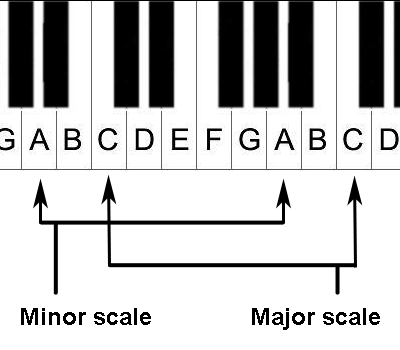Dealing with the relatives
"You can choose your friends but you can't choose your relatives." Especially when they're minors. It's the same thing for music because the relative minor is always defined the same way: it starts three half-steps down.
Many people are confused by the terms relative major and relative minor. Unless you're dealing with non-traditional music, it all turns out to be very simple. We're going to cover diatonic scales, pentatonic scales, and chords. And it will be surprisingly brief.
Once again this will be limited to the key of C just to make it easier to describe. The principles apply to any key.
A quick review: the C Major scale is a diatonic scale whose root is the note C. It is played on a piano using all of the white keys. You can play it on a guitar with only that knowledge and knowing where any C is located: just go up one fret for every piano key, black or white, but only play the ones that correspond to the white keys.
For reasons that I don't want to know, but I'm sure made sense at the time, every move from one note to the adjacent note (one fret, or one piano key) is called a half-step.
Every diatonic major scale has a relative minor scale which is also known as the Natural Minor. It is always located three half steps below the major scale. So the C Major scale—played by using all the white keys starting on C—has the relative minor of A Minor—played using all the white keys starting on A.

That's right. The Major scale and its relative Natural Minor scale both use exactly the same notes.
To emphasize the point: The key of G has one sharp, f#. The G Major has all the same notes as the C major scale, except the F is replaced by F#. Using those notes, if you start playing them with G then it's a G major. If you start down three half-steps lower, on E, you'll be playing a E Minor scale.
That's all there is to it.
What about chords?
Okay it's not the same notes. However they share two of the same notes. Let's look at why that's the case.
The root chord is built from the I, III and V notes of the scale, no matter what intervals are involved. For a C major that could be C, E and G. For an A minor that would be A, C and E.
As an aside, putting both of them together by adding the G to the end of the A minor gives you an A minor seven.
What about pentatonics?
It's the same story. The major pentatonic scale and its relative minor pentatonic scale use the same notes. The G major and E minor pentatonics are identical other than which note is considered the root (or I) note.
The G major shape, followed by the E minor shape. The circled note is the root. The other large, fading notes are the 3 and the 5 of the chord.
G major shape
E minor shape
That's it. Now wasn't that easy?


